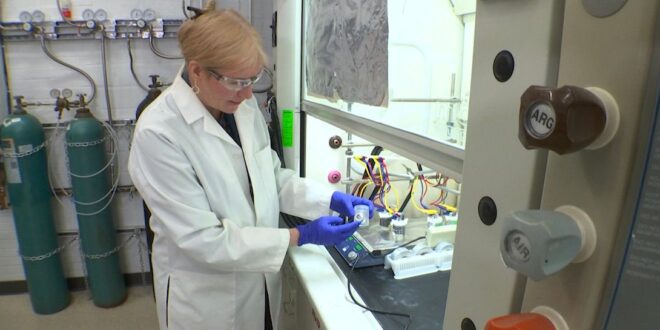rewrite the main part of
ROCHESTER, N.Y. — Scientists say millions of Americans are being exposed to “forever chemicals” in their drinking water, as wastewater treatment plants don’t have the capacity to remove all of them during the treatment process.
A recent study published by the National Academy of Sciences sheds light on a problem that researchers around the country are racing to fix. Researchers at the University of Rochester are confident they’ve found one solution to the perfluoroalkyl and polyfluoroalkyl substances (PFAS) problem.
Astrid Müller is a chemical engineering professor who is leading groundbreaking research in removing so-called “forever chemicals” from water. It’s called electrocatalysis. Putting a scientifically complicated process into simpler terms, two electrodes are placed into water containing PFAS. Salt is added to make the water conductive. UV light helps draw PFAS into the positively charged electrode, where the forever chemicals are destroyed.
“PFAS is, of course, a huge issue,” said Müller, whose research focuses on a particular type of PFAS called perflourooctane sulfonate.
PFAS have been linked to, among other things, certain cancers and developmental delays in children. But Müller says their usefulness in everything from solar panels to food packaging to medical devices and a host of other consumer products makes them critical to modern life.
“What makes them so incredibly useful, which is their strong CF bonds, also makes an incredibly persistent and hard to break down,” she said.
This is a challenge at wastewater treatment plants, which currently have ways to absorb PFAS but no way of breaking down forever chemicals. The cost of such a method is a major concern. Müller and her team at the University of Rochester use a pulsed laser in liquid synthesis to create nanocatalysts that are much more cost-effective than traditional methods of water purification — and can be used on a large scale.
“The cost is always a huge issue, of course,” said Müller. “And the lower the cost, the more adoptable technology will be and the more scalable, globally, it will be.
Researchers are also studying why certain PFAS break down easier than others. With thousands of types of forever chemicals in the environment, universities and private companies are racing to find solutions.
“It’s the Wild West out there right now,” she said.
Müller has filed a patent for her process. Aside from wastewater treatment plants, she says the process works on removing PFAS from firefighting foams used at airports and on military bases, and is useful for cleaning up contaminated industrial sites.
“We, of course, have to find ways to deal with them,” said Müller.
A new approach that’s not yet ready for the commercial market, but could someday find use around the globe.
“We know this is really crucial to accelerate the technology development,” Müller said.
between 300 to 1000 words in html format and use paragraphs and subheadings with h3 tags.
 Mind Uncharted Explore. Discover. Learn.
Mind Uncharted Explore. Discover. Learn.



